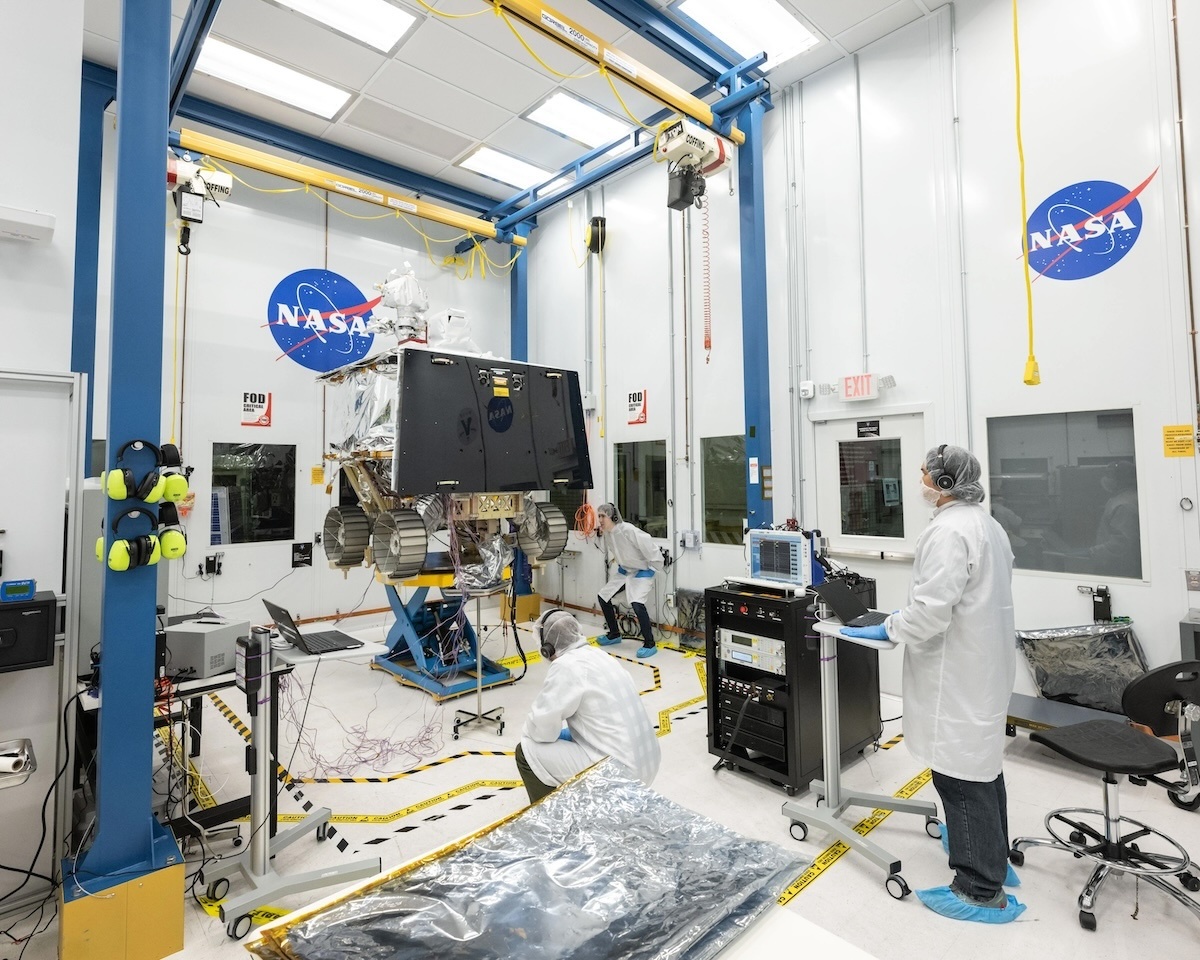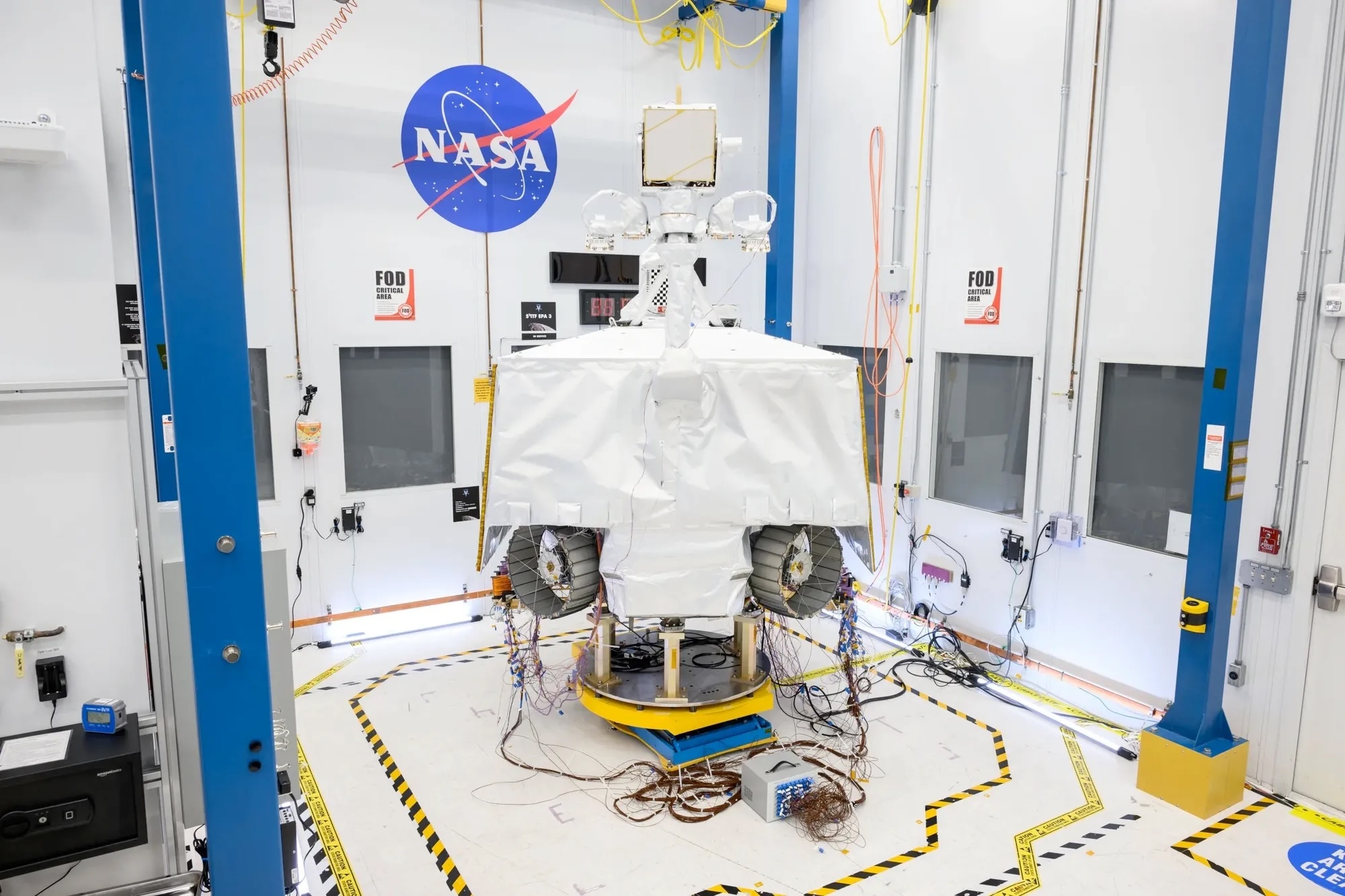16.05.2024

While NASA’s VIPER team has been focused on building the flight rover that will go to the South Pole of the Moon, the team has also been making preparations for environmental testing of the rover.
In April, the VIPER team passed a System Test Readiness Review, exploring the readiness of the facilities, procedures, and staff to move into stress-testing the VIPER rover.
These environmental tests are important because they force our rover to experience the conditions it will see during launch, landing, and in the thermal environment of operating at the lunar South Pole. Specifically, acoustic testing will simulate the harsh, vibrational “rock concert” experience of launch, while thermal-vacuum testing will expose VIPER to the hottest and coldest temperatures it will see during the mission, all while operating in the vacuum of space. It’s a tough business, but we have to make sure we’re up for it.
Thanks to this team for the hard efforts to get to this important phase in mission readiness!
Go VIPER!
– Dan Andrews, VIPER Project Manager
Quelle: NASA
----
Update: 15.08.2024
.
Intuitive Machines seeks to take over NASA’s VIPER lunar rover

NASA is continuing environmental tests of the VIPER lunar rover despite uncertainty about whether and if it will launch. Credit: NASA/Helen Arase Vargas
WASHINGTON — Intuitive Machines says it is organizing a coalition of organizations that will offer to take over a NASA lunar rover mission, launching it on one of the company’s landers.
In an Aug. 13 earnings call about its second quarter financial results, Intuitive Machines executives said they were planning to respond to a request for information (RFI) that NASA issued Aug. 9seeking input from companies and organizations interested in taking over the Volatiles Investigating Polar Exploration Rover (VIPER) mission that the agency said in July it would cancel.
Steve Altemus, chief executive of Intuitive Machines, said on the call that his company, which also responded to an earlier call for “expressions of interest” from NASA regarding VIPER, is working with other companies, universities and international partners on responding to NASA’s RFI. He did not identify any of those prospective partners.
“Our position there is that VIPER science is important to lunar scientists and the future of the Artemis program, and it’s very important in terms of prospecting for volatiles and entrained water ice in the soil,” he said.
NASA, in its RFI, said that prospective partners would be responsible for the costs of any final testing and other work on the rover itself, as well as delivering it to the lunar surface and operating it once there. NASA, in its July 17 announcement that it would cancel VIPER, said the agency would save at least $84 million by halting work now on the rover, now complete and undergoing environmental testing.
Altemus said the company is still working to understand what work will be left to do on VIPER once NASA ends work on it. “I don’t think that the $84 million budget left to go is actually real in terms of what we would do commercially,” he said. “That’s a government number. That’s not a commercial number, so it’s not that significant, in my opinion.”
He said Intuitive Machines would use its larger Nova-D lander, still in development, to deliver the 500-kilogram VIPER to the lunar surface. The company would seek to make money on the mission by selling excess payload capacity on Nova-D, which he said could carry up to 1,500 kilograms of payload.
“That gives us about 1,000 kilograms of extra payload space to improve the economics. If we can monetize that 1,000 kilograms, that will offset any costs for flying the mission commercially,” he said.
Responses to the RFI are due to NASA Sept. 2. Altemus said on the call that he expected to get a response from NASA about it later in September, although the agency has not disclosed a timeline for responses or the next steps it will take regarding VIPER. NASA is separately pursuing international partnership possibilities for VIPER.
If Intuitive Machines does get the opportunity to fly VIPER commercially, he said he expected the company to launch it in late 2027. NASA’s plans, as of its July decision to cancel the mission, projected a launch in September 2025.
Upcoming missions and other opportunities
Intuitive Machines reported revenue of $41.4 million in the second quarter, more than double the $18 million the company reported in the same quarter of 2023. It had an operating loss of $28.2 million in the quarter, also more than double the $13.2 million operating loss it reported in the same quarter a year ago.
The company attributed the increase in revenue to new work, such as a NASA engineering services contract that started late last year as well as initial work on a Lunar Terrain Vehicle Services contract the company received in April.
The increased losses came from what Steve Vontur, chief financial officer, described as “non-cash impacts” to modifications to its next two lunar lander missions, IM-2 and IM-3, both flying payloads for NASA’s Commercial Lunar Payload Services (CLPS) program.
“During the second quarter, we revised contract revenue and cost estimates to align with these modifications, which resulted in lowered progress towards completion,” he said. “However, the modifications reduced schedule uncertainty going forward on our next two missions.”
One modification, for the IM-2 mission, finalized the landing site for the mission. The company said in July that the new landing location is an elliptical region 200 meters across on the Shackleton Connecting Ridge near the lunar south pole. That region has favorable terrain, lighting and line-of-sight to the Earth for communications, and what the company said then was “high probability of ice stability” within one meter of the surface that could be accessed by instruments on the lander.
Altemus said in the call that the company now expected IM-2 to launch in December or early January, slightly later than previously projected. He said that slip was due to the contract modification for adjusting the landing site. In addition, Kennedy Space Center’s Launch Complex 39A, required for the launch, may not be available before late November because of the planned launch in October of NASA’s Europa Clipper and the time to reconfigure the pad afterwards from Falcon Heavy to Falcon 9.
“So we chose to move out of November and focus on the December-January timeframe for our launch attempts,” he said.
The next mission, IM-3, will be delayed because of “NASA payload delivery dates moving to the right,” he said. The company is now projecting that mission to launch in October or November of 2025.
In the company’s Form 10-Q filing with the U.S. Securities and Exchange Commission Aug. 13, the company said the CLPS task order modification from NASA for the IM-2 mission is worth $12.5 million, and brings the estimated revenue from the mission from NASA and commercial customers to $122.4 million. The modification for IM-3, to be finalized in the third quarter, is valued at about $10 million, with total revenue of $86.9 million as of the end of the second quarter.
The company added in that SEC filing that both the IM-2 and IM-3 missions are in “loss positions.” The loss on IM-2 increased by $7.1 million in the quarter and IM-3 by $10.9 million, which the company blamed on “unfavorable adjustments” from the task order modifications.
Altemus said in the call that he expects NASA to award the next CLPS task order, CP-22, later this month. The NASA CLPS program manager, Chris Culbert, said at the AIAA ASCEND conference Aug. 1 that the agency was “very close” to awarding that task order, which would be for a mission to the lunar south polar region.
Intuitive Machines is also awaiting NASA’s award of contracts for its Near Space Network Services (NSNS) program, where the agency will buy communications services for missions operating withing two million kilometers of the Earth, including on and around the moon.
“The award for the NSNS contract is imminent, and we believe Intuitive Machines is uniquely positioned to win and deliver orbiting lunar data satellites in support of autonomously operated infrastructure on and around the moon,” he said. There are two separate awards, one for direct-to-Earth communications and the other for relay services, that he said the company expected to be issued in August or September.
Quelle: SN
